Table of contents
- Not a competitor to magnetic tape
- Life after DiscoVision
- Conclusion
Not a competitor to magnetic tape
LaserDisc did not conquer the market even in the early stages because it never entered the videotape race. This conclusion can be drawn if you get acquainted with the culture of home entertainment in the late seventies in the United States.
Putting aside the print media and the game console industry in its infancy, at home the American could either listen to music or watch serials on TV. You didn't have to pay for music on the radio - at least not in money. In rotation, the radio stations kept a set of songs in which the same melody was repeated several times a day. If a song was particularly popular, the record stores sold tape or vinyl records. The TV gives you access to TV shows and occasionally broadcast movies.
It may seem that there is a place here for a device that can play movies. Reality decreed otherwise.
Compare advertisements for the first VCRs in the US and Magnavox laser players. An advertisement for the Magnavox MP-8005 player from Home Video Entertainment magazine from 1982. The advertisement is false because it promotes the interactive features of the format, and this player does not support access to chapters or frames. At the time of the ad, the 8005 was no longer on sale, the 8010 went on sale.
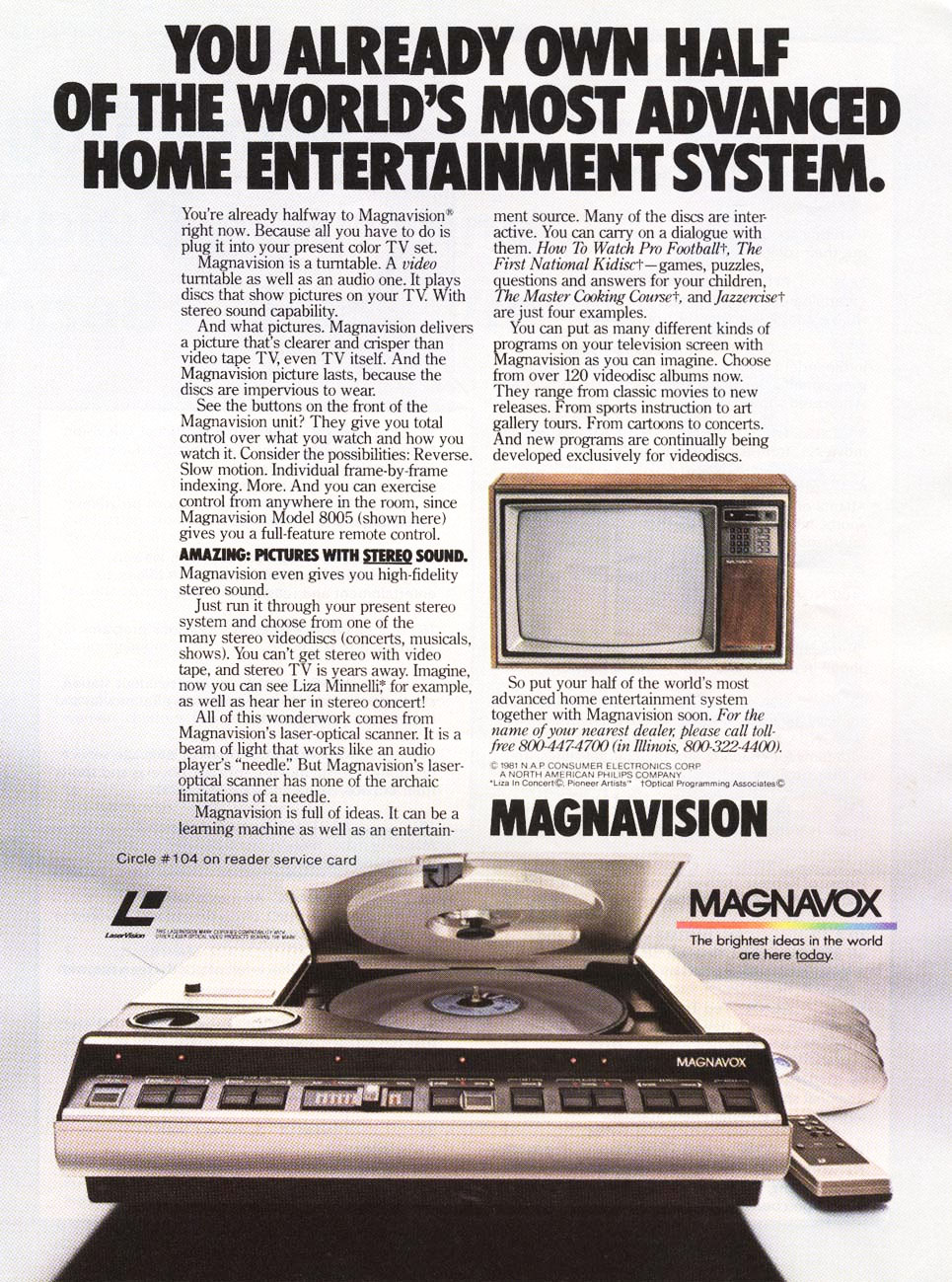
LaserDisc player advertisements are promoting the system as a "video turntable," an advanced device for user-controlled interactive entertainment. A clear picture and stereo sound can be seen and heard not on every TV: at that time they were small and with a single speaker. Advertising brochures are scattered around the content descriptions of DiscoVision systems.
Of course, it was impossible to argue with the sound and picture quality of the futuristic laser player, but it could only play pre-recorded content, which was purchased separately. And in general, why buy films that you are going to watch one, at most two times? LaserDisc solved a problem that consumers did not have. Advertising video recorder Sony Betamax SL-8600
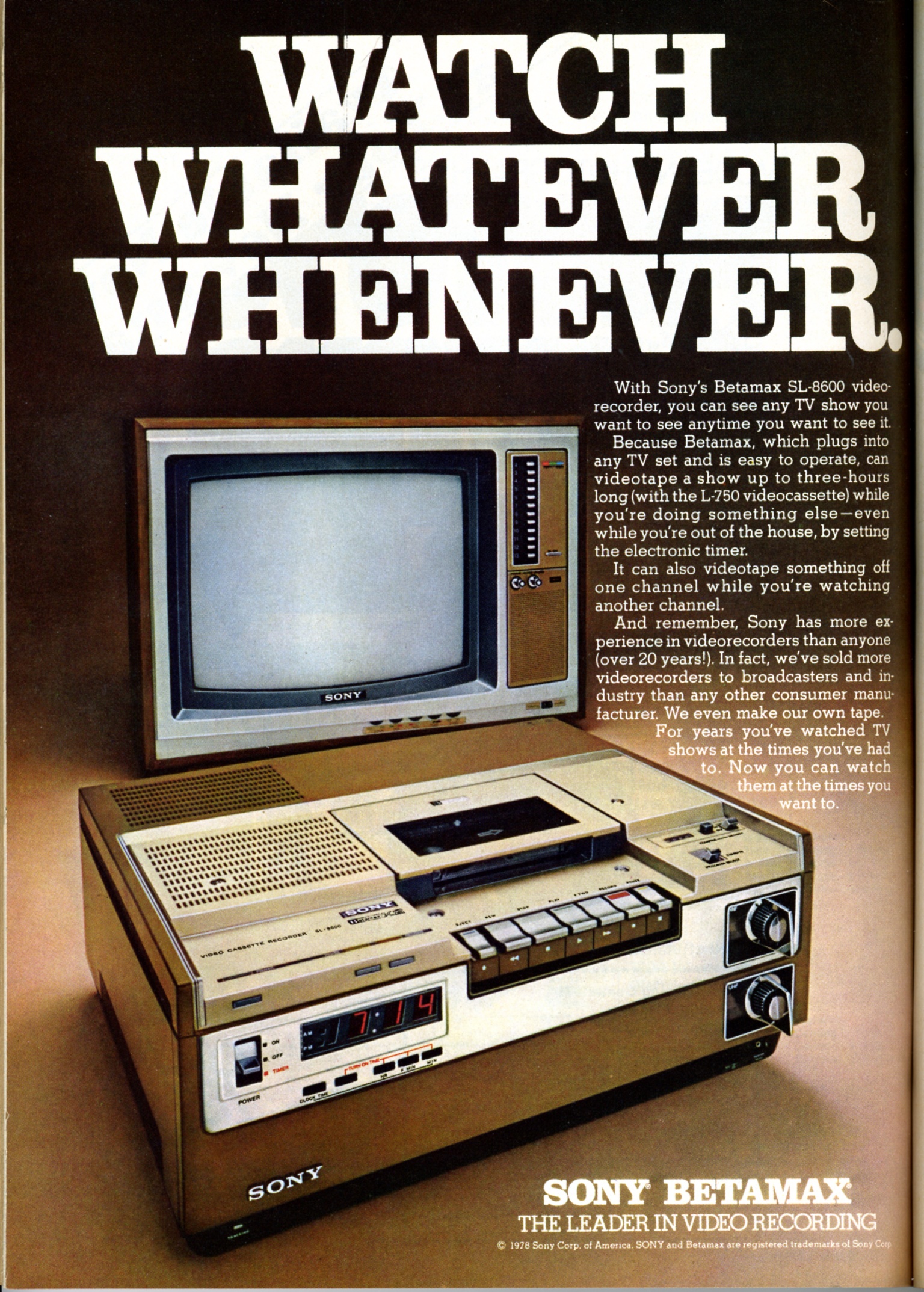
... Released in 1979, that is, around the start of the DiscoVision systems. The original MSRP is $ 1,150. The first Betamax player with a digital clock. The slogan reads "Watch Anything Anytime".
It’s easy to see the difference in advertisements for early VCRs: they do n’t say anything about playing movies from pre-recorded videotapes . These are devices for recording television for viewing at a convenient time.
In the fifties of the last century, television entered the culture of the United States. In 1950, only 20% of American households had a television. Three years later, every second family has TV. By the end of the decade, televisions were in nearly 9 out of 10 American homes.
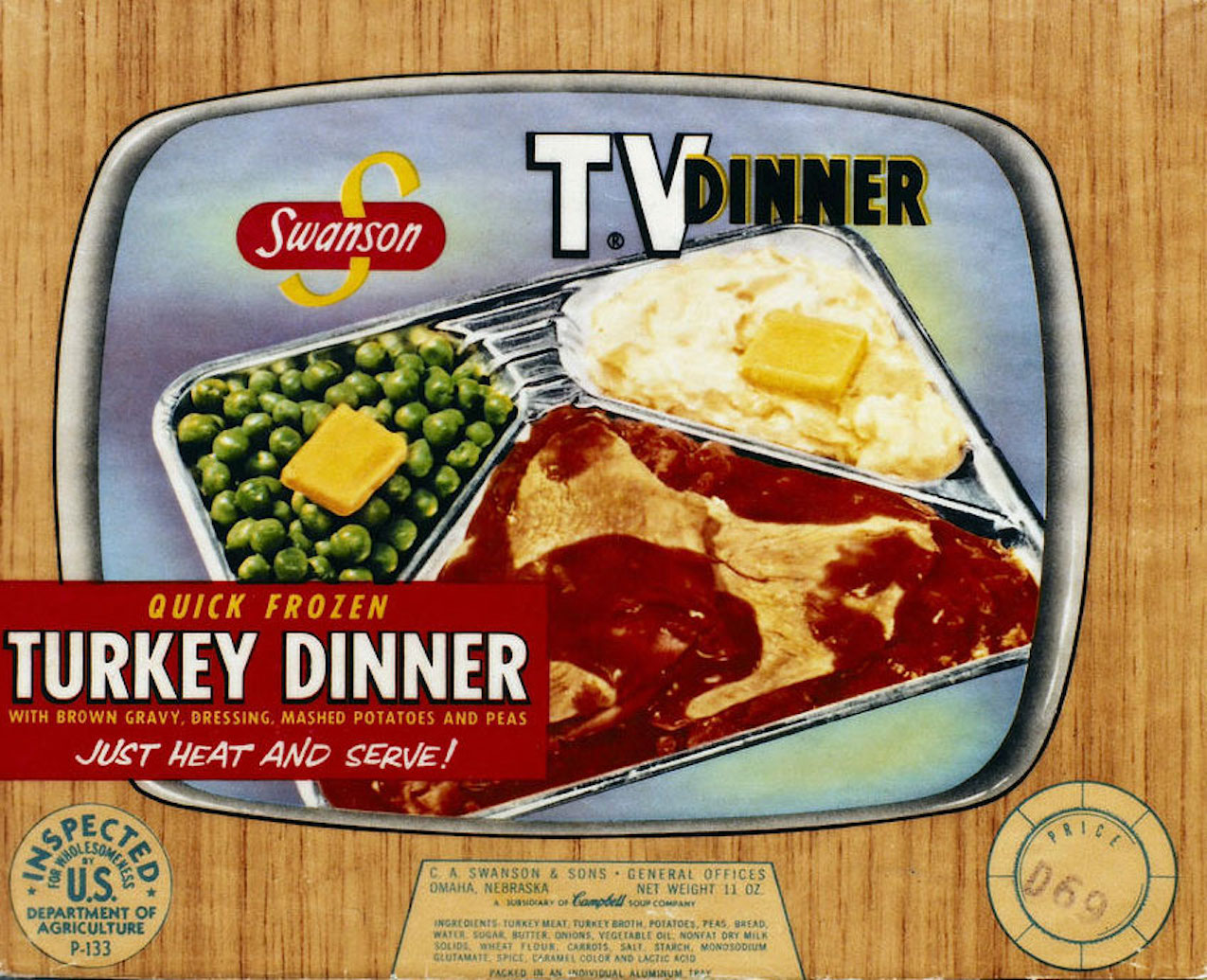
Television was such a strong status symbol that it was branded products far from video technology - and very successfully. Swanson's frozen food, for example, owes part of its popularity to the TV Dinner name . Of course, there were other factors: after World War II, more and more women worked in families, and dinner at the Americans' was the main meal of the day. But if the dinner was "television", then it was strongly associated with convenience and technical progress.
By 1975, television was the norm: only 2.9% of US households did not have a television. Americans have formed the habit of keeping track of the program schedule, cheering for their favorite team on the broadcast of sports events, and regularly watching television series.
An unpleasant detail of television: it happens on a schedule that cannot be controlled. It is not always possible to catch the episode of your favorite program on time, and some shows are even too late for a working person. Early television (up to the sixties) generally took place exclusively on air, and if there was no recording of a kinescope on tape, then the program simply did not reach our days. For example, the early Doctor Who is partially lost . If there is a record, the series can be shown again ( reran ), but the decision is for the TV company.
The TV is a device for the whole family. Although there were three TV channels at that time in the United States , sometimes households needed to watch different channels at the same time.
This is why VCRs have been touted primarily as timer recorders rather than movie players. Even the cost of the cassettes was not such a determining factor: if you want to, you can get by with one. In the early years, LaserDisc simply did not perform the same functions and did not compete directly with Betamax / VHS.
The market for pre-recorded cassettes gradually emerged.
VCRs only at the start cost like an airplane wing. JVC did not require any VHS licensing and freely distributed the standard, so everything was riveted on their decks. By 1985, the $ 250 VCR had the same set of features as the $ 1300 from 1977. The same did not happen with LaserDisc: Pioneer proudly sculpted a $ 800-900 price tag on the CLD-900...
VCRs came to many, which solved the chicken-and-egg problem of having a market for content, which LaserDisc initially couldn't handle. And video rental services “spread” the cost of video cassettes to several consumers. You don't have to buy an expensive cassette to make - you can rent it. MCA forgot to think about it when they invented their format.
LaserDisc survived, but no longer in the winning position.
Life after DiscoVision
In September 1979, MCA partnered with IBM to form DiscoVision Associates (DVA) for the video disc business. This gives MCA access to a $ 50 million investment from IBM, which of course will run out sooner or later.
In the meantime, Pioneer in Japan successfully set up production of its own players and slowly began to develop the technology. Initially, the Japanese had a license only for the production of turntables, but after fierce negotiations MCA gave the right to duplicate discs. Already in October 1980, discs began to be printed in Japan, including those for the United States.
The turmoil at the MCA factory in Carson and the high automation of cleaner production in Kofu turned the "Printed in Japan" signature on the disc into a guarantee of performance and relative picture clarity. And MCA had no plans to clean up the American replication factory, as sales were not growing.
Examples of degradation of varying severity on LaserDisc.
Don't think Pioneer didn't have its own problems. By 1984, the term "laser rot" - degradation of LaserDisc media - came into use. Discs that looked perfect on the day of purchase would suddenly get snow. The picture was filled with noise, the sound acquired a static noise. The condition of the disc could deteriorate either to a complete inoperability, or to the point where even the player lost tracking. The culprit was the glue, a component of which negatively affected the reflective layer of the disc. By mid-1985, Pioneer had largely fixed the problem, although the lifespan of optical drives is still limited.
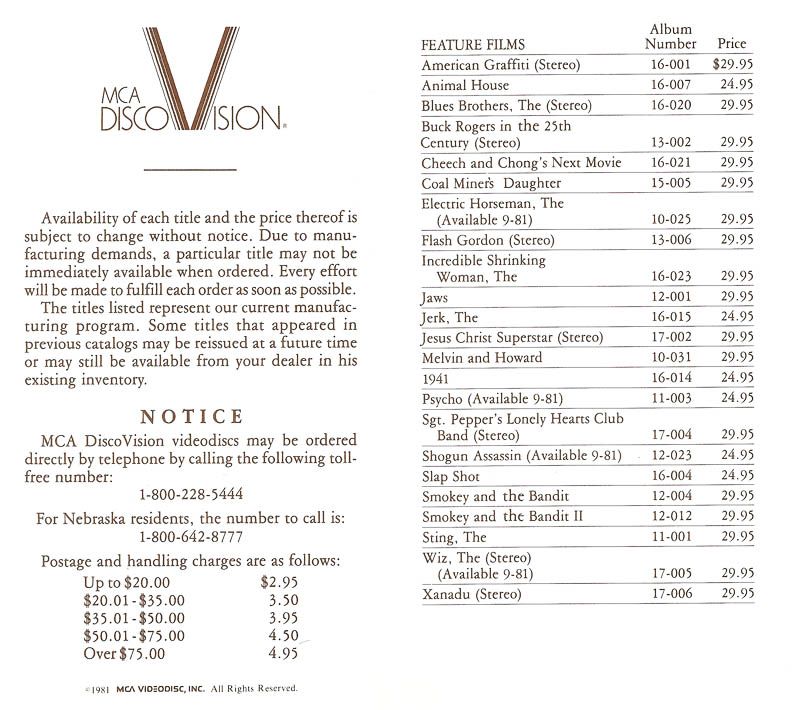
Front page of DiscoVision's latest new releases booklet, July 1981 .
By 1981, DiscoVision's catalog of new releases had long ceased to grow, and DVA's money was starting to run out. The staff of the Carson disc replication plant was cut to the last limit, production slowed, and there was talk of selling capacity. DiscoVision's July 1981 booklet contains 35 titles in total.
After months of negotiations, in February 1982, Pioneer announces the purchase of the Carson factory. The Japanese closed this plant for re-equipment, after its completion Carson began to produce discs of average quality. In 1989, even patents went to Japan: IBM and MCA sold the rest of DiscoVision Associates in their entirety for $ 200 million. But even before that, Pioneer had virtually complete control of the LaserDisc, making adjustments to the standard.
Throughout its life, LaserDisc felt much better in Japan: they buy content more often than rent, and the low cost of the media came in handy. But even in Japan, by the end of the format's life, only 10% of households had an LD player .
In addition to the Japanese, LaserDisc was bought by high quality video lovers all over the world. For us, this may seem strange, since analog laser discs had a number of, if not disadvantages, then certainly features.
The 30cm optical disc is exactly the same size as the 12 "vinyl album. The technology developers decided to please stores and ordinary users with the similarity of sizes. Similar packaging, similar shelves, but not weight: each optical disc weighed just over 200 grams, slightly heavier than a vinyl record of the same size. At the same time in the player it spun up to 1800 rpm (1500 for the PAL region). Even the spinning process itself took a few seconds, and the smooth hum of the engine continued during operation. The videotapes, in their hardcover form, were much nicer to transport.
What format will you choose to deliver cartoons to your child: a wearable analog optical disc that can be scratched on the coffee table, or a hard block of plastic with magnetic tape protection? LaserDisc was also out of touch with real life.
The cost of the players started from $ 300 and went up to 1500. And the video quality varied greatly from model to model, since the format is analog. The same DVDs read about the same in any player, since they are digital. While a digital DVD release, due to error correction codes, can withstand even a visually noticeable scratch around the entire radius of the disc without degrading quality, the analog nature of LaserDisc turned any defect on the disc into a defect on the screen and in the speakers.
An example of a scratch on a disc.
On a CAV (Constant Angular Velocity) disk with a constant angular velocity, up to 30/36 minutes of video fit, CLV (Constant Linear Velocity) with a constant linear velocity worked up to 60/64 minutes (NTSC / PAL, respectively). CAV is the first option, and all the first movie releases were on it. Freeze frame on CAV discs worked without a special memory buffer, which was present only on expensive players. The CAV disk stored 54,000 frames, and the user could immediately jump to any of them. This, by the way, was used by commercial image storage systems.
On the other hand, two CLV sides of one disc can hold 120 minutes of video, which is one typical full-length film. In CLV, chapter navigation also worked, albeit a little slower due to the spin-up of the disc.

CAV- , . . — , . — .
Due to disc mastering errors or malfunctions in the tilt mechanism, the laser would sometimes read an adjacent or even both adjacent tracks, resulting in artifacts on the screen. To combat this, Pioneer slightly improved the CLV standard in 1982 to include CAA (Constant Angular Acceleration) with constant angular acceleration. For a CAA disc, the decrease in angular velocity does not occur gradually, but in steps. Almost all manufacturers have adopted the CAA scheme, and on the disc packaging it was not marked with any marks - the new players already supported CAA. For the first time, CAA was used in the edition of "Star Wars", but in general Pioneer switched between CAA and "clean" CLV in production until mid-1993. Sometimes even the same release included CAA and CLV disks.
Movie playback was really about changing the disc. At least once an hour, you had to interrupt the viewing, go to the player and turn the disc, and then wait for it to spin again. Expensive player models could move the laser up, but there was still a pause for spinning in the opposite direction.
Probably due to the high cost of the laser, a complex layout with transportation was used, rather than a second laser. Here Sony installed a U-shaped rail on which the laser walks.
For all its features, the LaserDisc did have a sharper picture, and Pioneer's marketing boldly promised a picture "60% sharper than VHS." With proper handling and no scrap, optical discs wore out less than magnetic tape. This, incidentally, determined the interest in them in commercial organizations, schools and government agencies.
Early attempts at high definition television were analog. MUSE standardwas developed to transmit images with a resolution of 1920 × 1035, in Japan MUSE broadcasting began back in 1991. To record this on LaserDisc, special players were developed with more accurate optics and higher rotation speeds - 2700 rpm versus 1800 for conventional discs. Due to the high cost, this system did not go far, and there are a total of 24 different discs in MUSE HiVision that were produced exclusively for the Japanese market.
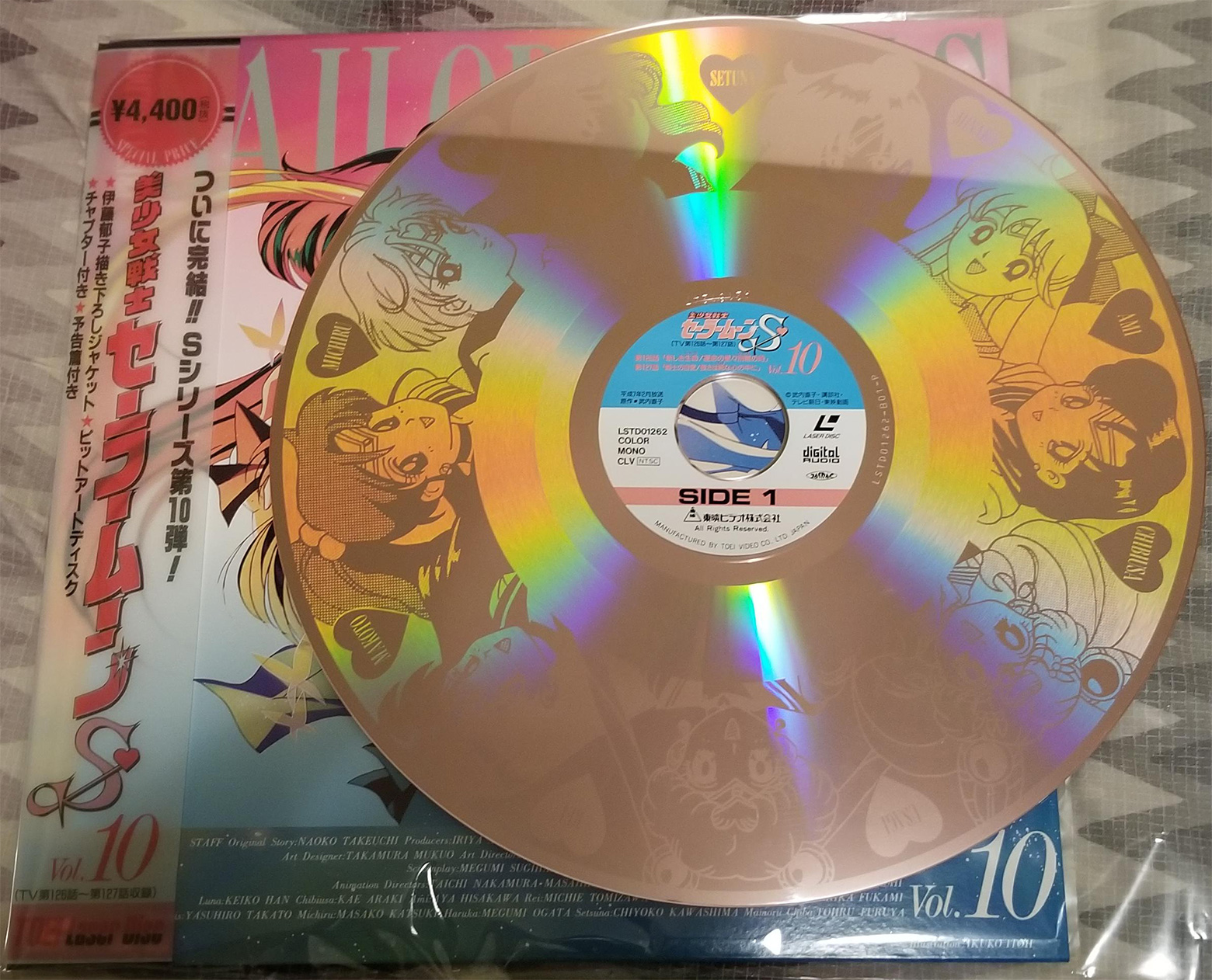
Art with characters on the blank side of the disc. Source: Reddit .
The original LaserDisc had two channels of analog audio and was considered high quality at the time of release. Later, CX noise reduction was introduced for analog channels. Analogue channels for the NTSC region were often used for additional information such as a commentary track. The production of players with support for analog audio only ended in 1989.
In 1982, the consumer became familiar with CD and uncompressed digital audio. In 1985 Pioneer added digital audio to LaserDisc with the same characteristics as CD: 44.1 kHz (44,056 for NTSC) and 16 bits for each of the two channels. Due to technical features, PAL discs could have either 2 analog channels or 2 digital channels, NTSC discs did not have this limitation. By the end of the eighties, the digital track became the norm, discs without it ceased to be released.
By the nineties, conventional stereo was not enough - even a home theater was expected to be surrounded by sound. With Dolby Surround Pro-Logic technology, a stereo digital decoder receives 4-channel audio: 3 channels (left, front, right) with full bandwidth (5 Hz to 20 kHz) and 1 surround back channel (100-7000 Hz) ).
Dolby Digital / AC-3 support was compressed 384 kbps on the right analog channel. Without an AC-3 decoder, only static noise will be heard, with it - 5 channels from 5 Hz to 20 kHz and a subwoofer channel 2-120 Hz. Finally, 5.1 sound was done with DTS, but with a bitrate of 1.4 Mbps on both digital channels. For this, again, a DTS decoder was needed, which was connected to the player.
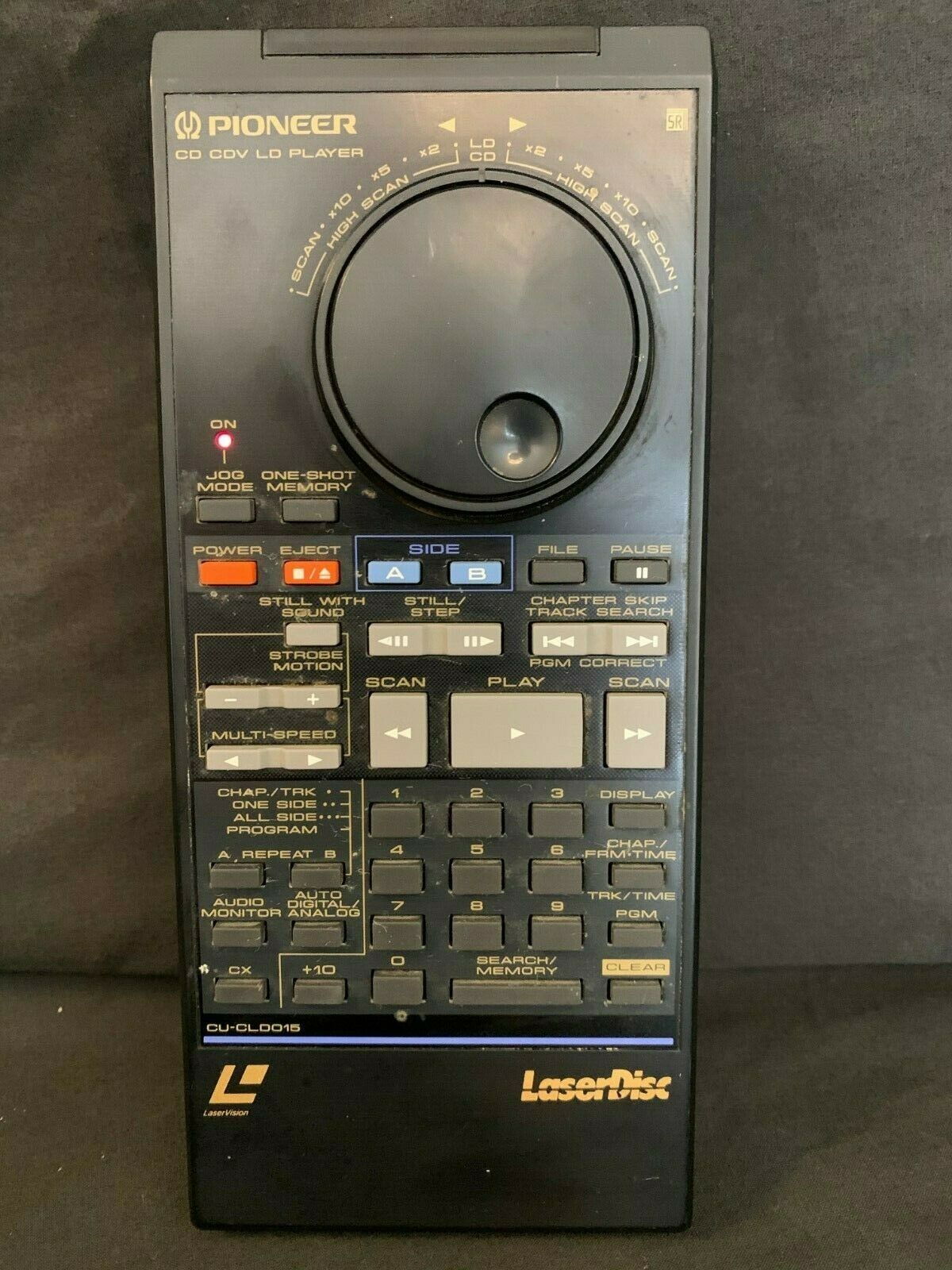
Pioneer CLD-3070 player remote control with playback speed control wheel.
Bonus content for extended editions of films included short documentaries and trailers. The still image on LaserDisc does not contain the distortion that is inevitable in VCRs. The perfect still frame for CAV discs allowed for a slideshow of pictures: the meta marks on the disc told the player to stop playback, and then the user moved forward one frame at a time. So the disc included any interesting images, for example, photos from the set.
An example of images of a similar slideshow. Playback is slow: in the video structure, these are only individual frames.
The interactive capabilities of CAV discs have made them an attractive solution for creating interactive video systems for museums or advertisements. In Japan, LaserDisc has long been the preferred format for karaoke.
The speed of access of CAV discs was used to create slot machines . For all the beauty of the graphics, the gameplay of Dragon's Lairlimited: this would be contemptuously called cutscenes and quick time events today. The player presses the right button at the right moment, and the slot machine only goes to the video fragment. Today we would joke that this is a click × to win level, but for 1983 it seemed interesting. The game even made it to the Smithsonian Museum. Prior to that, only two games (Pong and Pac-Man) had such an honor. Dragon's Lair was followed by similar projects, for example, Space Ace .
Read in a row the disc of the game Dragon's Lair.
Compact cameras and the availability of technology have created a boom for home and semi-pro video. Videos were distributed on cassettes on any topic: from handicraft fitness guides to police films about the dangers of cold steel . The home camcorder worked on any convenient occasion, and then the family watched it on the VCR. None of this would have happened on a huge 12-inch disc that had to be published royalty-free.
For the inhabitants of the space inside the Iron Curtain, the most interesting thing is that the magnetic tape, albeit with loss of quality, is copied. Handicraft translations of American cinema in the USSR would never have become a reality if some complex proprietary format guided home videos.
LaserDisc technologies laid the foundation for what became the CD. In the late nineties, LD handed over the baton to his successor, the DVD. The films on LaserDisc were released in the United States until 2000, with their last release in Japan on October 21, 2001.
LaserDisc won the hearts of the cinephiles of the eighties and nineties. In the analog video era, it remained the more expensive option for moviegoers and affluent people.
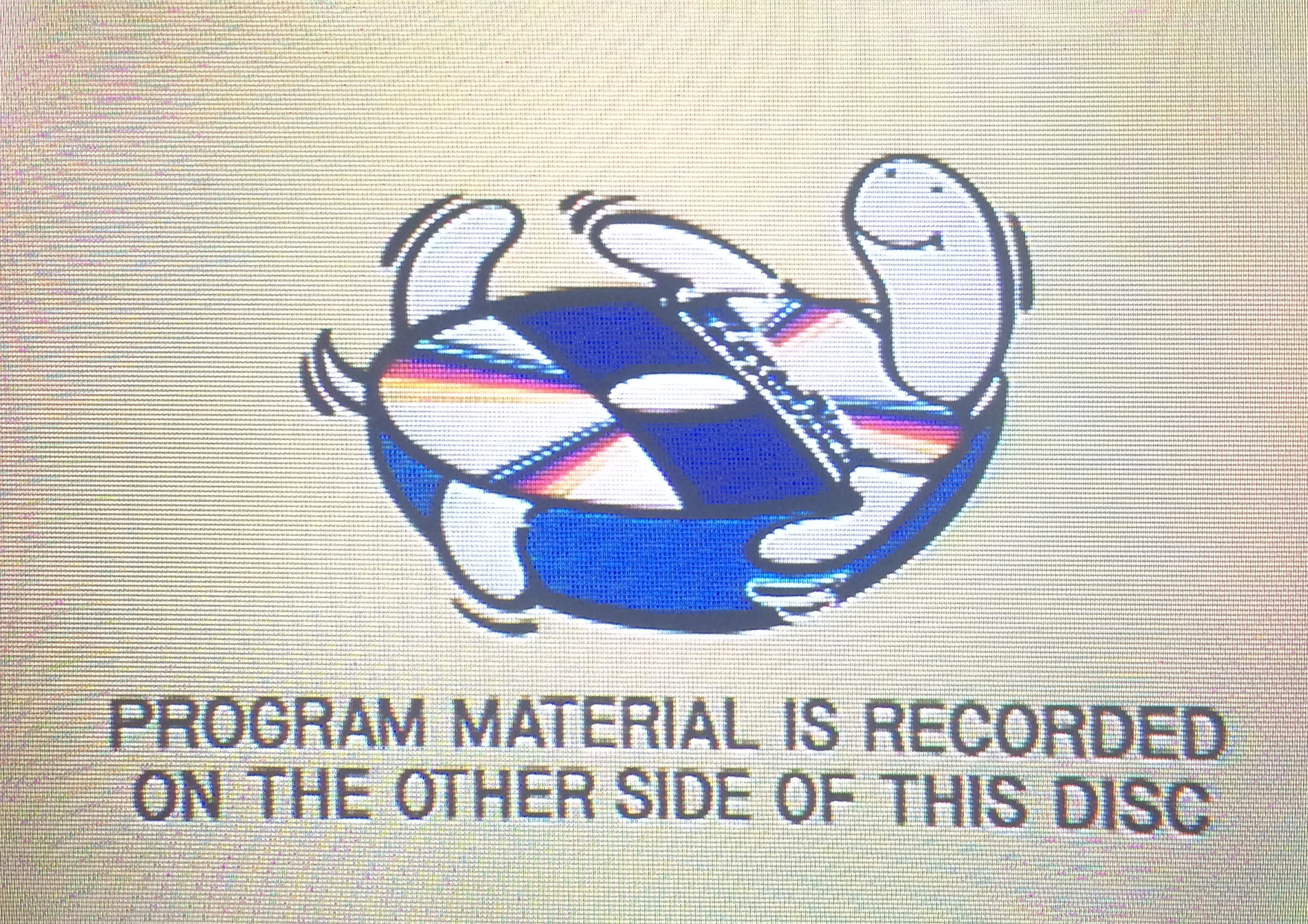
Based on materials from AVS Forum , Blam1 ( 1 , 2 , 3 , 4 , 5 , 6 , 7 , 8 , 9 , 10 ), Randocity and ura-CALDC...